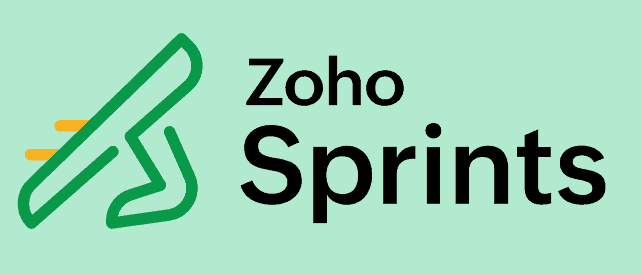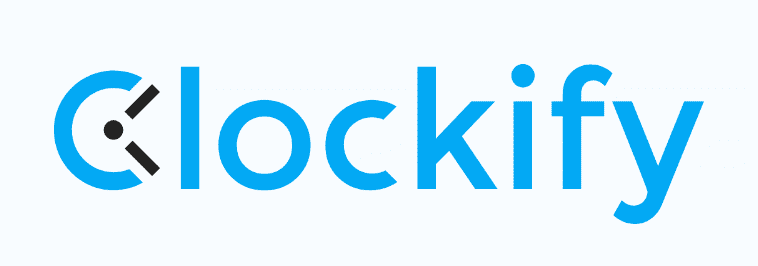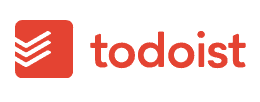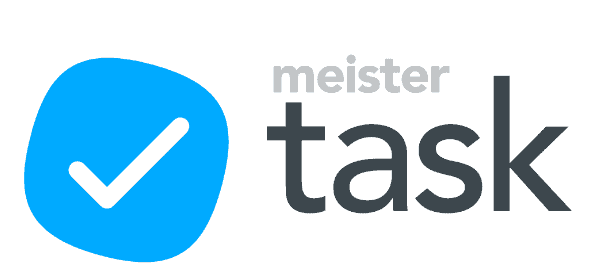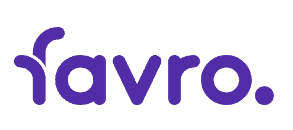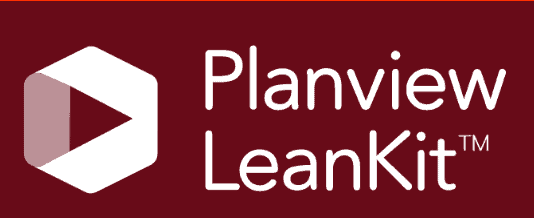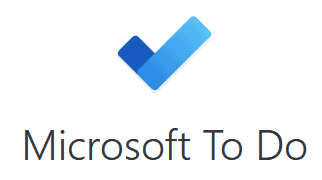Airtable Review
Airtable is what it looks like when you combine the power of a relational database with flexible project management software. In this comprehensive Airtable review, we explore what makes more than 450,000 organizations worldwide use Airtable and if this platform is all you need to streamline your workflow.
Key Takeaways: Airtable Review
- Airtable is a highly customizable project and database management tool that can be optimized to meet the specific needs of any team.
- It has one of the most intuitive and user-friendly interfaces among project management software.
- Airtable’s free plan comes with a generous amount of functionality that is perfect for individuals and small teams.
Airtable has gained a strong reputation as project management software largely due to a powerful database, high flexibility and ease of use. In this Airtable review, we will delve into the pros and cons of the software, its key features, insights from our hands-on testing and more.
Don’t let the word database scare you — Airtable is easy to use and has a user-friendly interface. The software offers a wide range of customizations that make it suitable for different project needs. However, there may be a slight learning curve initially for those who are unfamiliar with spreadsheet-style apps.
If you’re looking for other project management tools to compare, make sure to check out our best project management software article for some great alternatives.
-
05/25/2023
Our Airtable review has been rewritten with new information and an easy-to-read format.
-
12/01/2023 Facts checked
This article was rewritten with updated features and pricing, adding a how-to section and using a new format.
-
06/25/2024 Facts checked
We have updated our Airtable review with new information regarding integrations and HIPAA compliance.
What Is Airtable & Who Is It For?
Airtable is a cloud-based database creation and data management tool. It was founded in 2012 by Howie Liu, Andrew Ofstad and Emmett Nicholas. Airtable has an intuitive, spreadsheet-like interface that sits on top of a relational database backend. This allows users to easily create custom databases and applications without any coding knowledge.
Avoid Costly Project Management Mistakes – Get Free Tips Today!
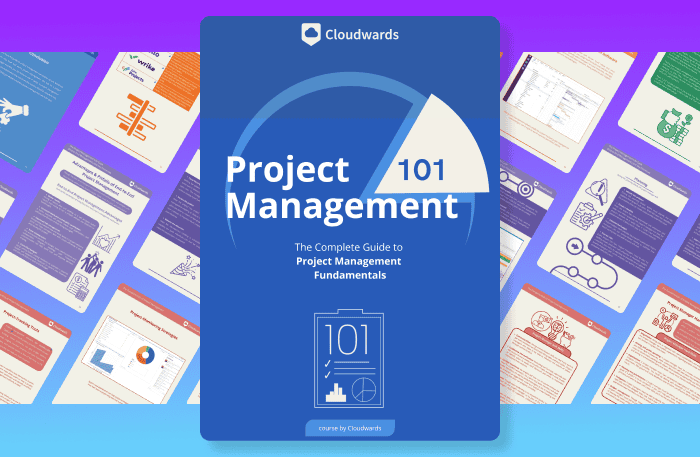
- Discover 10 fundamentals of project management
- Understand step-by-step plans for PM execution
- Learn tips to avoid 5 common mistakes by beginners
The tool’s flexibility has made it a suitable option for a wide range of teams and industries, from software development teams to marketing agencies and e-commerce companies. Over 450,000 organizations across many industries use Airtable to streamline their business operations, including companies like Dropbox, Spotify and LinkedIn.
Airtable: The Cloudwards Expert Opinion
Airtable does a very good job of managing data and projects. We’re impressed with its customizability, and the intuitive interface is also a big plus. Over time, the platform has gradually improved and added new features, turning simple database software into a versatile tool.
However, we found that Airtable may fall short for more complex statistics and analytics. Additionally, its updated pricing plans can be expensive for small businesses.
Airtable: Pros & Cons
Pros:
- Free plan is fantastic
- User-friendly interface
- Multiple views are available
- Lots of customization options
- Lots of plugins & integrations
Cons:
- Collaboration could be better
- Mobile apps could be better
- Limited scalability for larger enterprises
- Steep pricing for small teams
Airtable Alternatives
- 1
- 2
- 3
- 4
- 5
- 6
- 7
- 8$59 / month(All Plans)
- 9
- 10
- 11
- 12
- 13$3 / month(All Plans)
- 14$7.25 / month(All Plans)
- 15$4 / month(All Plans)
- 16$1 / month(All Plans)
- 17
- 18
- 19
- 20
- 21
- 22
- 23
- 24$10 / month(All Plans)
- 25
- 26
- 27
- 28
- 29
- 30
- 31
- 32
- 33
- 34
- 35
- 36
- 37
- 38$2.08 / month(All Plans)
- 39
- 40
- 41
- 42$15 / month(All Plans)
- 43
- 44
- 45
- 46$20 / month(All Plans)
- 47
- 48
- 49$910 / month(All Plans)
- 50
- 51
- 52
- 53
- 54$15 / month(All Plans)
- 55
- 56
Features: What Can Airtable Do?
Airtable is a versatile tool that combines project management features and spreadsheet software. You can not only centralize information for your workflow but also manage projects, assign tasks and track projects’ progress. Like any project management tool, Airtable is not without its limitations, though. Let’s dive into its key features in more detail.
Data Management
Whether it’s a social media calendar or inventory management, Airtable lets you capture all your important data in a “base” (short for database), the central home for any specific project.
Within a base, you can create tables (spreadsheets) and then enter new data into records (essentially rows within a spreadsheet), the smallest unit of your Airtable base. You can further organize data with custom fields (columns) based on information types, like dates and texts.
Additionally, the core of Airtable is a relational database. This means you can link related records across different tables in the entire database to create relationships between relevant pieces of data. You can also use the Airtable Sync feature to sync records from a source to one or more bases.
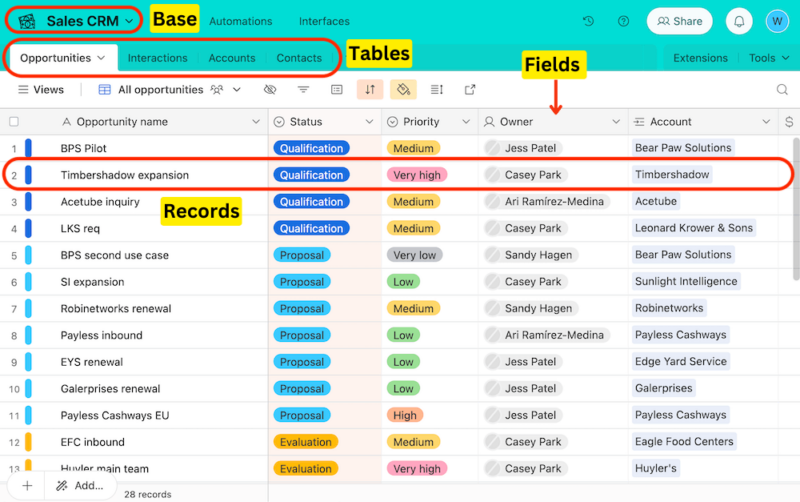
Project and Workflow Management Features
Airtable sets itself apart from Google Sheets with its capabilities for project and workflow management. Airtable has dozens of pre-built templates that you can use to get started quickly and customize to your project’s needs.
The task management features are also impressive and intuitive. You can easily set due dates, assign project tasks to team members and prioritize them based on importance.
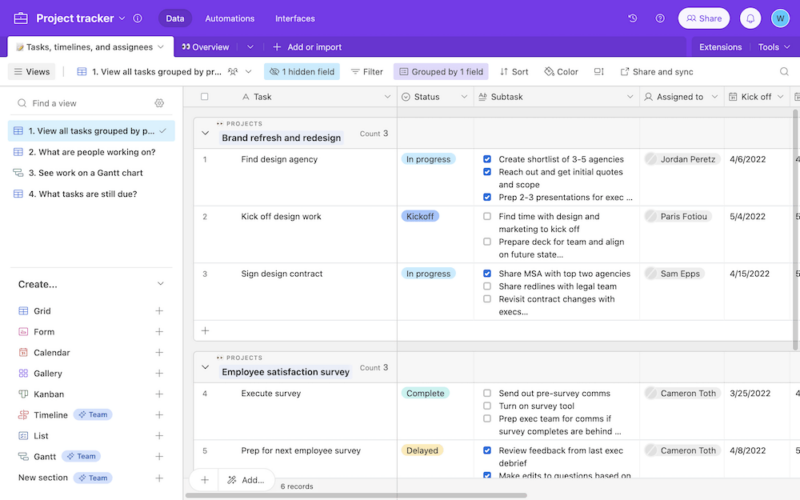
Another key feature of Airtable that we like is the wide range of views it offers for monitoring workflows. This includes a grid, calendar, form, kanban, gallery, list, Gantt charts and timeline views. Airtable is one of the best Trello alternatives because its Kanban board is one of the best we have used. It’s visually appealing, and you can set it up based on the field of your choice, like priority or status.
As well as offering many native workflow tools, Airtable can also integrate with numerous third-party applications like Slack, Google Drive and Salesforce. Additionally, Airtable can integrate with Asana, Box, Jira, Evernote and more, meaning you can consolidate workflows from multiple platforms.
The platform also lets you create custom views, giving you the flexibility to display and find data in a way that works best for you. You can hide or show any fields, filter and group data based on specific conditions, sort data in a particular order and even color-code your data to make it visually easier to identify.
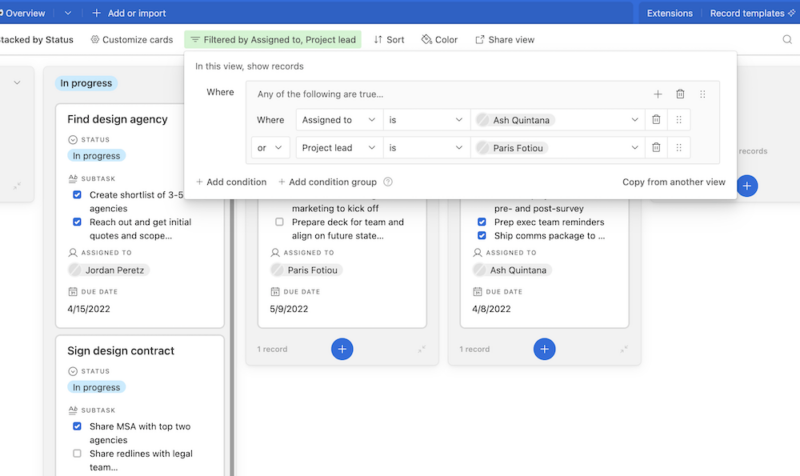
how you visualize and organize your data.
Interface Designer
Airtable offers even deeper customization than just custom views — it gives you the ability to create custom interfaces. The “interface designer” feature allows you to pull in existing data from your base and customize the layout to your needs, then share it with any team member or stakeholder. We like how this can be done with simple drag-and-drop functionality, no technical knowledge required.
This makes Airtable a more appealing option when compared to other platforms like Smartsheet. Smartsheet is packed with features useful for teams that handle for more complex workflows and tasks — you can find more info in our Smartsheet vs Airtable comparison.
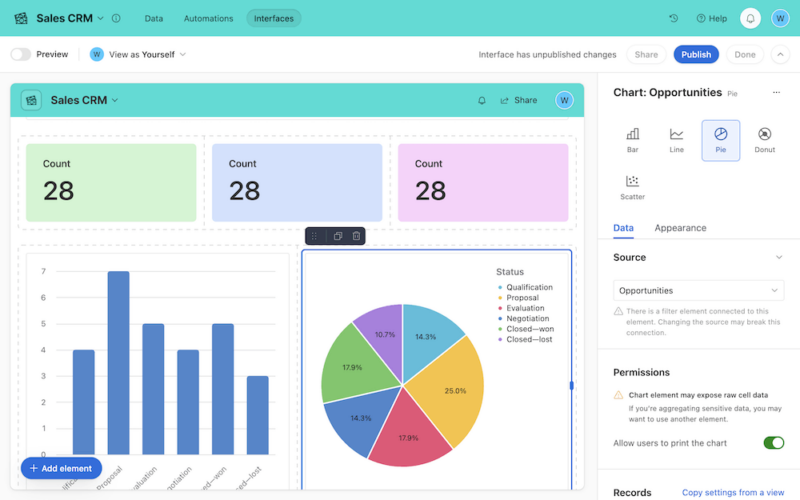
Team Collaboration Tools
Airtable offers basic but decent collaboration features. You can invite team members to your base and assign them different levels of access. To communicate within a team, Airtable has features like commenting on records and mentioning team members. However, if your project relies heavily on collaboration and extensive communication, you may find other apps, like ClickUp or monday.com, more suitable.
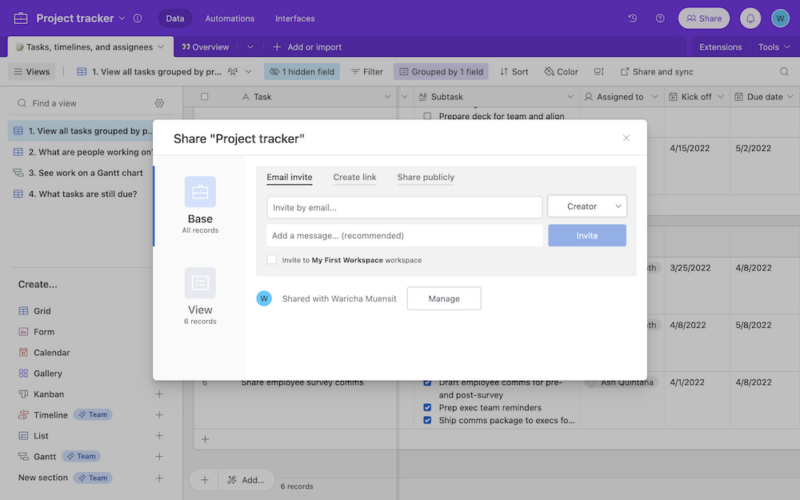
For paid plans, the creators or owners of a base can limit who can create or delete records in a table with table editing permissions. This option is available only on the web browser, macOS and Windows apps.
Personal and locked views can also be used to prevent others from changing a view’s configuration. This is particularly helpful if you are working on sensitive projects or with multiple team members.
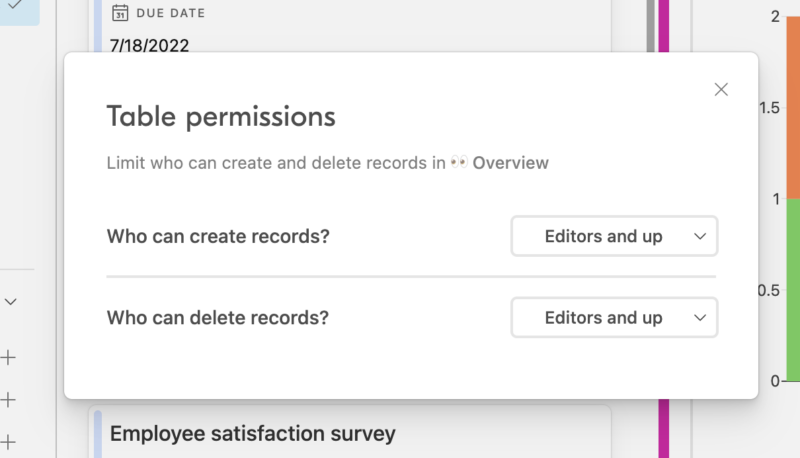
Automations
Automations on Airtable are based on a trigger-and-action model (when a “trigger” occurs, an “action” follows). You can build an automation within Airtable’s base or integrate with third-party apps like Google Workspace, Google Drive and Outlook. However, the number of automations you can run per month depends on the plan you have chosen.
If you’re working on complex projects or need more automation flexibility, you can also write your own formulas on Airtable.
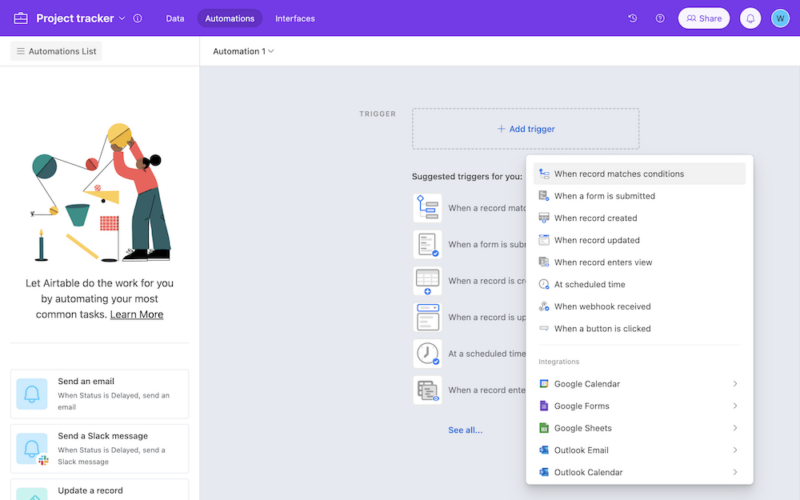
Airtable Features Overview
| Features | |
|---|---|
| Kanban board | |
| List | |
| Calendar | |
| Timeline | |
| Spreadsheet view | |
| Gantt charts | |
| Workload planning | |
| Long-term planning | |
| Multiple project management | |
| Dependency management | |
| Native scrum management | |
| Set user permissions | |
| File storage | |
| Time-tracking | |
| Built-in integrations | |
| Reporting features | |
| Free plan | |
| Free Trial | 14 days |
| Web app | |
| Windows | |
| MacOS | |
| Android | |
| iOS | |
| AI Tools | |
| Ticket-based support | |
| Tutorials | |
| Knowledgebase | |
| Forum | |
| Live chat | |
| Phone support |
User-Friendliness & Hands-On Testing
Airtable’s user interface is well-known for its user-friendliness and intuitive design. The colorful scheme and customization options also add to the overall enjoyable user experience. Airtable stands out among other database management platforms for its ease of use. However, those who are new to database tools may need some time to fully grasp its functionalities.
How to Install Airtable
Below is a step-by-step guide on how to sign up and install Airtable on your computer.
- Sign Up for Airtable
Visit the Airtable website and click on the “sign up for free” button.
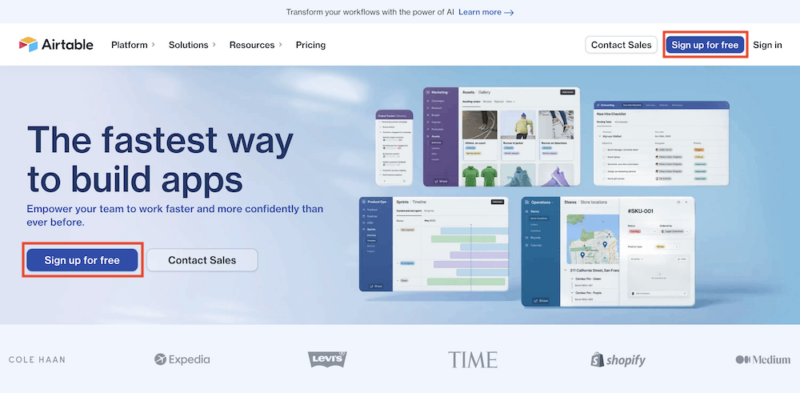
- Create Your Free Account
Enter your email address or continue with your Google account, Apple ID or Single Sign-On. If you enter an email address, you’ll then need to enter your full name and create a password for your account. Airtable will ask you a few questions to personalize your experience, but you can skip them if you prefer.
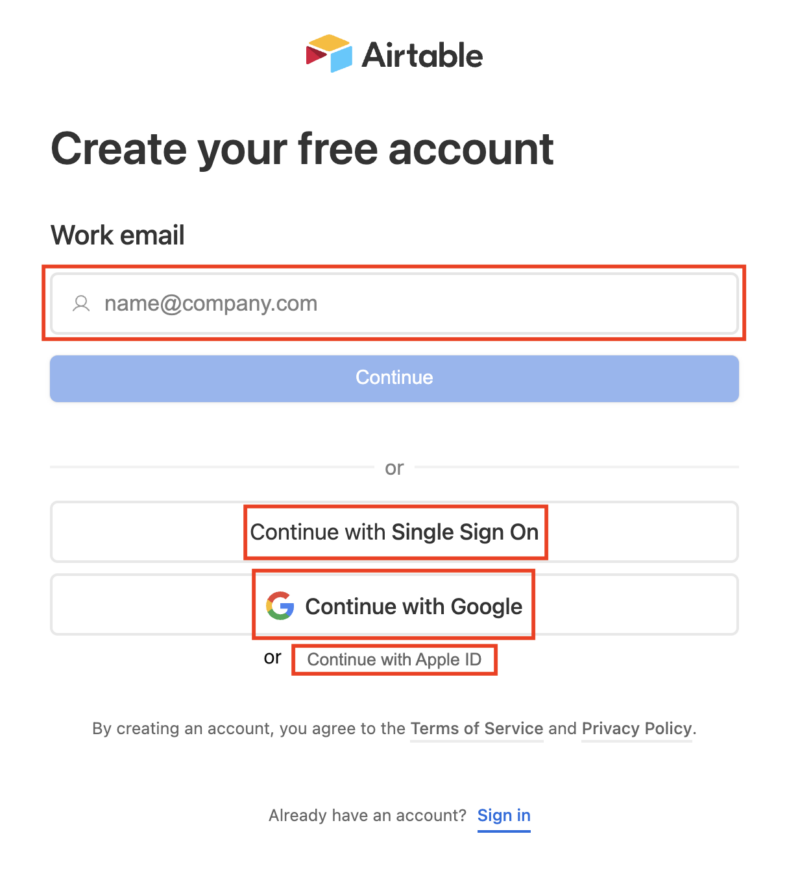
- Confirm Your Email
After signing up, Airtable will send you an email to confirm your email address. Open the email and click on the “confirm my email” button or copy and paste the verification link into your browser.
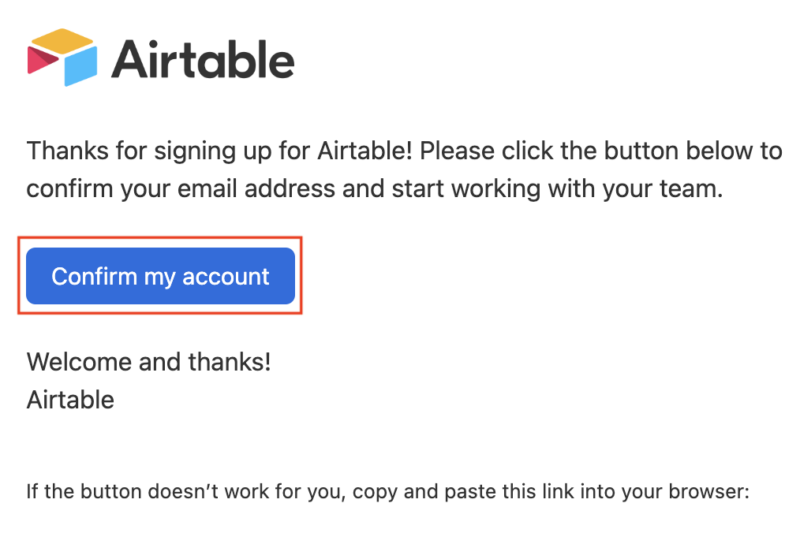
- Download and Install Airtable on Your Computer
Visit Airtable’s download page. From there, you can select the download link for your operating system. Once the download is complete, follow the on-screen instructions to install Airtable on your computer. Now you’re ready to use Airtable to organize and manage databases efficiently.
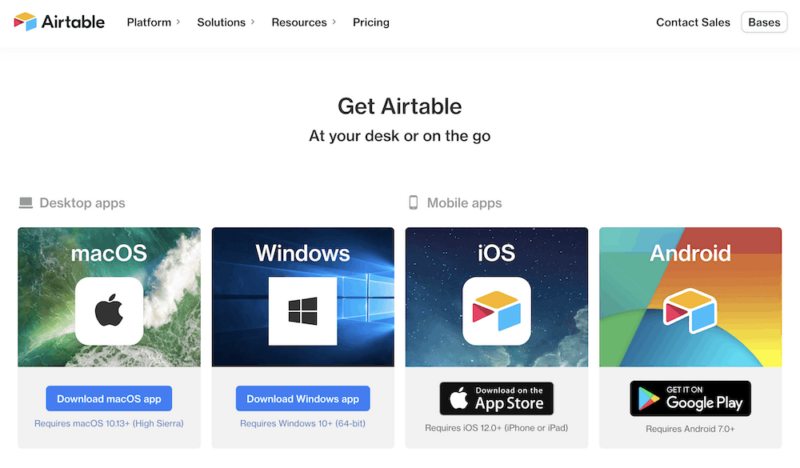
How to Set Up and Use Airtable
We’ll show you how to sign in to Airtable and set up your workspace for database management.
- Sign In to Airtable
Open Airtable on your computer or web browser and sign in with the account that you created during the sign-up process.
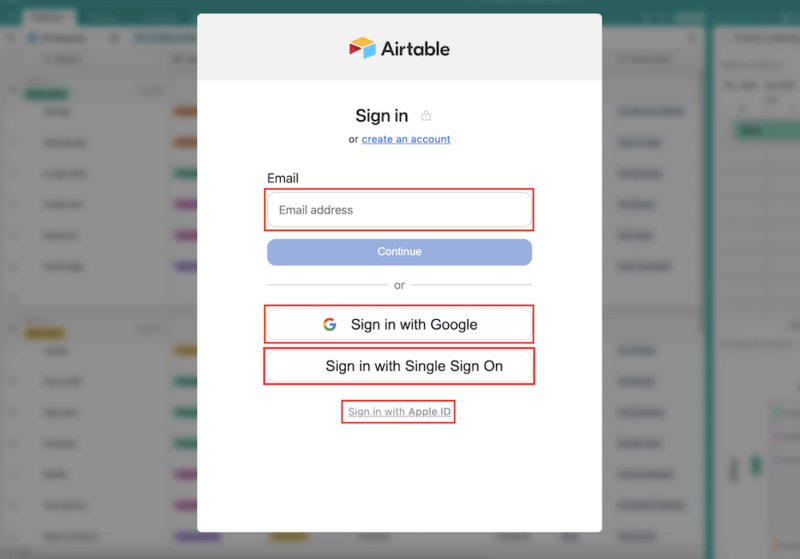
- Create a Base
On the homepage, click on the “create a base” button. You can also choose “start from scratch” if you want to create a new blank base or “start with templates” to get started with premade templates provided by Airtable.
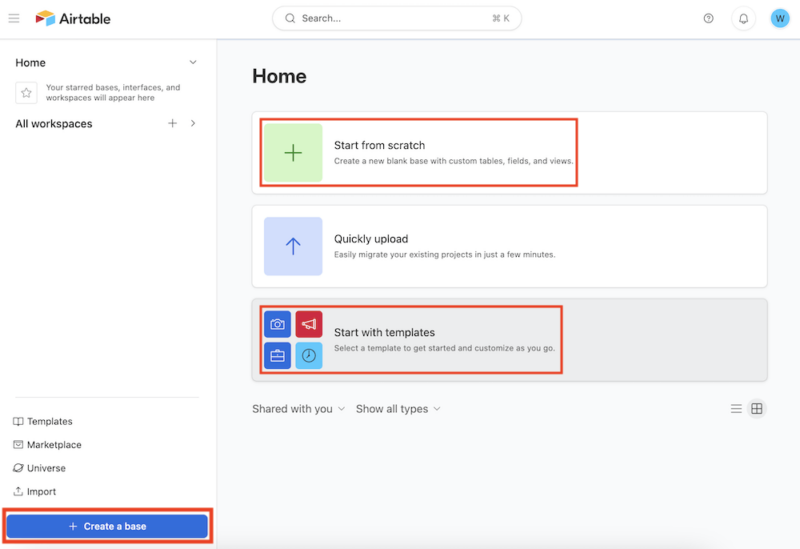
- Create a Table or Import Data
Click on the “add or import” button. You’ll have the option to create a blank table or import your data from other sources.
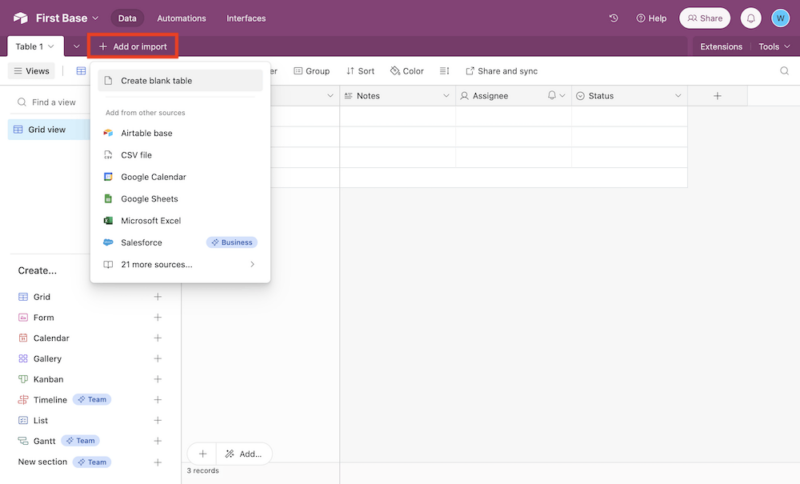
- Backup and Restore a Base
You can backup and restore your base’s data with the revision and snapshot history features. Click on the history button at the top right, then choose the “snapshots” option and click “take snapshot.” However, bases restored from snapshots do not have revision history but will include record comments.
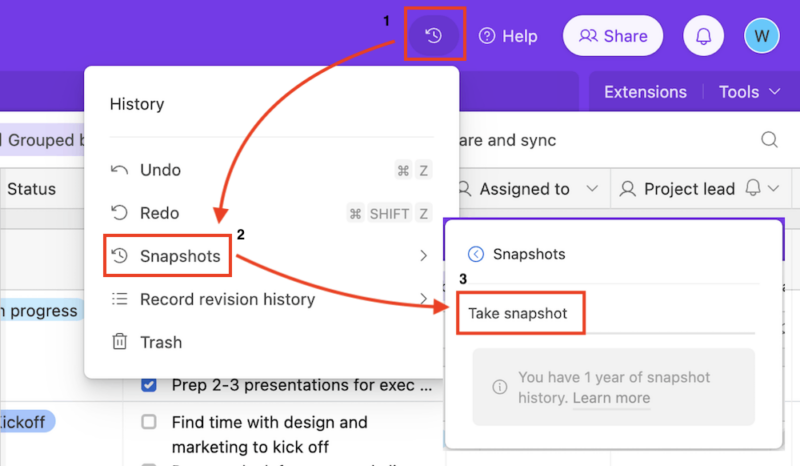
Airtable macOS & Windows Apps
Airtable’s desktop interface is clean and intuitive. The font is in an easy-to-read format, but you can’t configure the font size or style. Additionally, you have many options to customize your own workspace, whether creating custom views or designing an interface you like with Airtable’s “interface designer” tool.
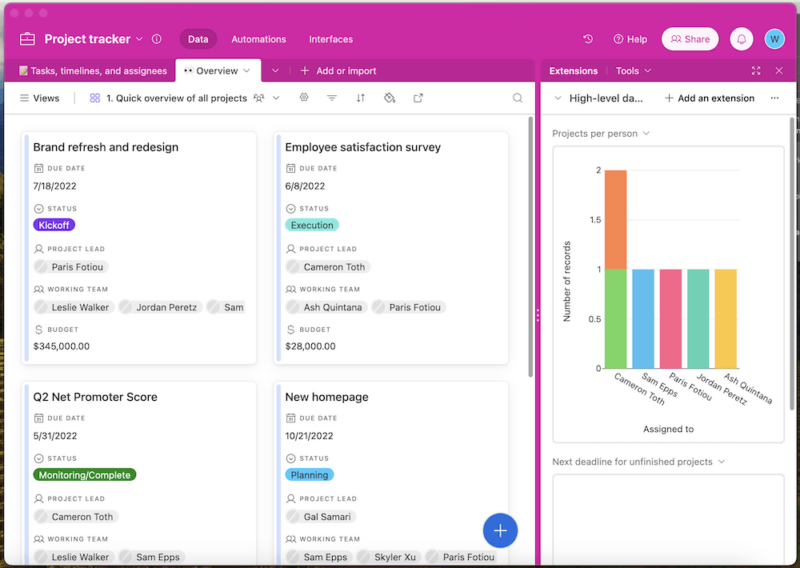
Navigating Airtable on macOS is straightforward. You’ll easily find the features and tools you need. Airtable also has onboarding tips to help you get started. If you’re new to Airtable, you can quickly access Airtable’s help for tutorials and guides on how to use the platform. Overall, Airtable has one of the best desktop interfaces and user experiences on the market.
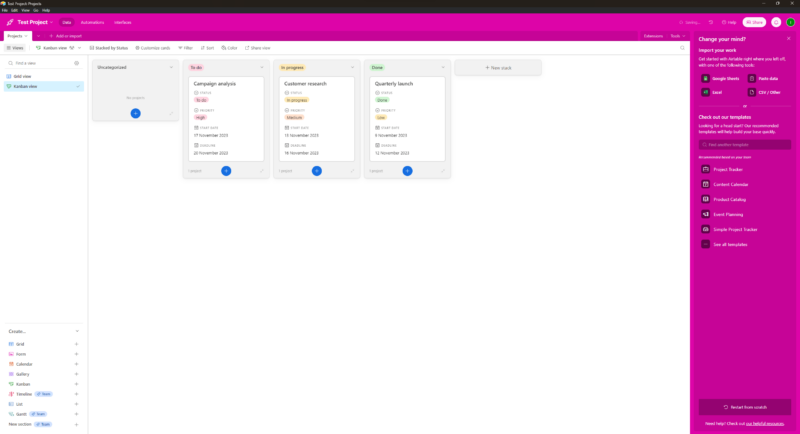
Airtable Android and iOS Apps
As much as we love desktop apps, Airtable’s mobile apps still need some work. The apps’ interfaces are clean, though the font is a bit small. The default spreadsheet view can be overwhelming when looking for data, but Kanban and gallery views are much more appealing and easier to navigate on the mobile apps.
Also, the mobile apps lack some features available on the desktop version, such as formula fields, Gantt and timeline views, automations and some extensions.
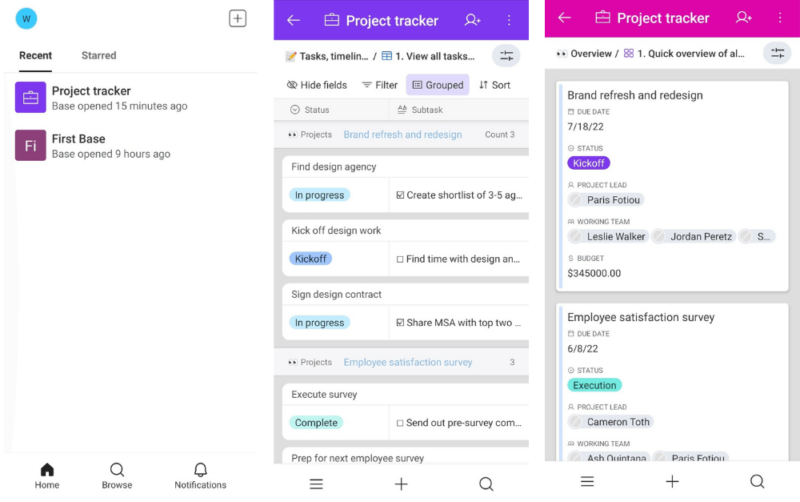
When comparing Airtable’s apps to other platforms on the market, we find that monday.com has a more robust and feature-rich mobile app (read our monday.com review). However, while there are areas for improvement, Airtable mobile apps still provide a convenient way to access your data on the go.
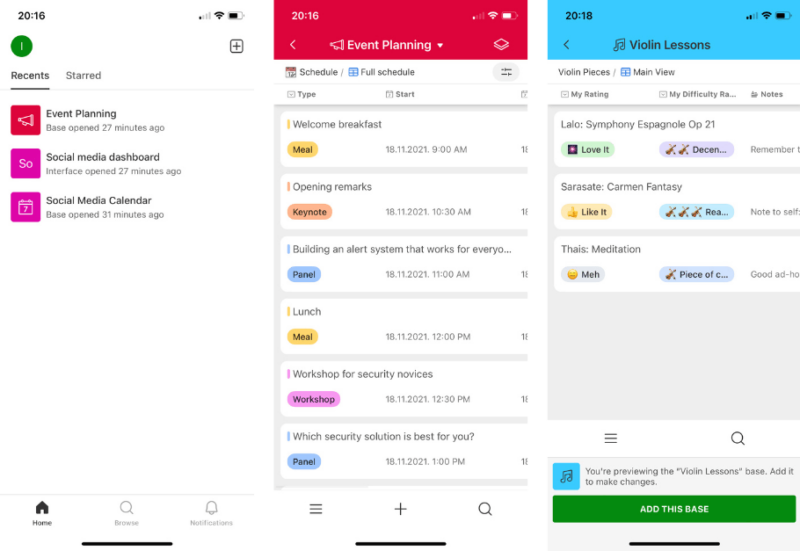
If you prefer a more minimalistic note-taking type of project management platform, read our guide on Notion vs Airtable comparison.
Airtable Pricing: How Much Does Airtable Cost?
Airtable has both free and paid plans. Its paid plans include Team, Business and Enterprise Scale. The pricing structure is charged per user per month and offers increasing levels of advanced features and usage quotas. Airtable changed its plans on Aug. 23, 2023, which resulted in a fairly steep increase in pricing.
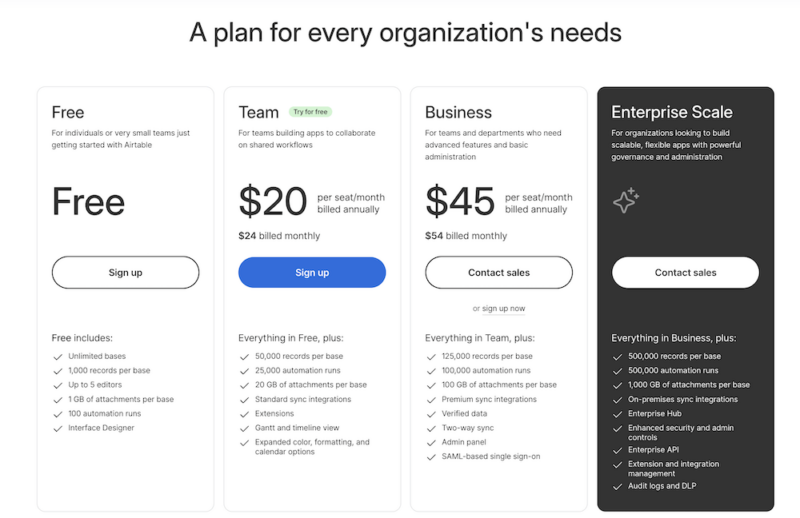
Airtable Free Plan
Airtable’s free plan is fantastic. It includes up to five users. You can create an unlimited number of bases with 1,000 records and 1GB of storage space for attachments per base. It also supports revision and snapshot history for two weeks. The grid, calendar, form, Kanban board, gallery and list views are also available.
You can run 100 automations per month. Overall, the free version offers a generous set of features for small teams or individuals.
Pricing Plan Breakdown
For all paid plans, you only pay for users who can create, edit or make significant changes in Airtable. Let’s take a closer look at the cost breakdown for each of Airtable’s paid plans.
Airtable Team Plan
The Team plan has everything in the free plan, plus unlimited users, 50,000 records and 20GB of storage space per base. Gantt charts and timeline views are added, as well as extensions and custom-branded forms. You can run 25,000 automations per month. More advanced permissions, like granular interface permissions, are available, as well.
The Team plan costs $20 per user per month when billed annually or $24 per user per month when billed monthly. The price is considerably higher than that of its competitors, even when compared to ClickUp’s top tier (here’s ClickUp’s pricing guide). You can try the Team plan’s 14-day free trial before committing to the higher price.
Airtable Business Plan
The Business plan offers 125,000 records and 100GB of storage per base, as well as 100,000 automation runs per month. Admin controls, single sign-on (SSO) and premium integrations with third-party services are added.
Note that the Business plan’s price jumps from the Team plan. The price starts at $45 per user per month when billed annually and goes up to $54 per user per month when billed monthly. After reviewing feedback from the Airtable community, we found reactions to the pricing jump to be quite negative.
Airtable Enterprise Plan
The Enterprise Scale plan includes everything in the Business plan, plus 500,000 records, 1TB of storage per base and 500,000 automation runs monthly. This plan is designed for large enterprises that require a customized solution tailored to their specific requirements. You need to contact sales for pricing details.
- Up to five users. Unlimited bases. 1,000 records, 1GB of storage per base. Revision and snapshot history for two weeks. Views: grid, calendar, form, Kanban board, gallery and list. 100 automations per month.
- Everything in free, plus unlimited users, 50,000 records and 20GB of storage space per base. Adds Gantt charts and timeline views. 25,000 automations per month.
- Everything in Team, plus 125,000 records, 100GB of storage per base, 100,000 automation per month. Admin controls, single sign-on (SSO) and premium integrations with third-party services.
- Everything in Business, plus 500,000 records, 1TB of storage per base, and 500,000 automation monthly.
Security & Privacy: Is Airtable Safe?
Airtable’s security and privacy measures conform to industry standards and are included in every plan. Business and Enterprise plans offer additional layers of security and privacy features, like SAML-based single sign-on (SSO), for large enterprises. The Enterprise plan is also HIPAA compliant.
Despite this, we recommend that you avoid storing highly confidential information on the platform unless you encrypt it first. Using two-factor authentication (2FA) is also recommended for added security.
Detailed Security Analysis
Airtable has implemented several security features to protect user data. It has ISO/IEC 27001 certification as well as SOC 2 compliance, which ensures the security and privacy of customer data. Airtable’s servers are located in the U.S.
Like most project management software, it stores data on Amazon Web Services, encrypts data during transmission with TLS 256-bit and encrypts data at rest with AES 256-bit.
Airtable Privacy Policy
We have reviewed Airtable’s privacy policy and found it to be transparent. Airtable collects information from you, such as personal details and data from integrated third-party applications on your account, but doesn’t sell or share this information with third parties.
Airtable is fully compliant with the General Data Protection Regulation (GDPR) and California Consumer Privacy Act.
Airtable Customer Support
Airtable provides customer support through various channels. For those who prefer self-service, Airtable has a comprehensive help center, guides that provide step-by-step instructions and a YouTube channel. We also like that it has an active and helpful Airtable community. Additionally, it provides a chatbot and an internal support team through email.
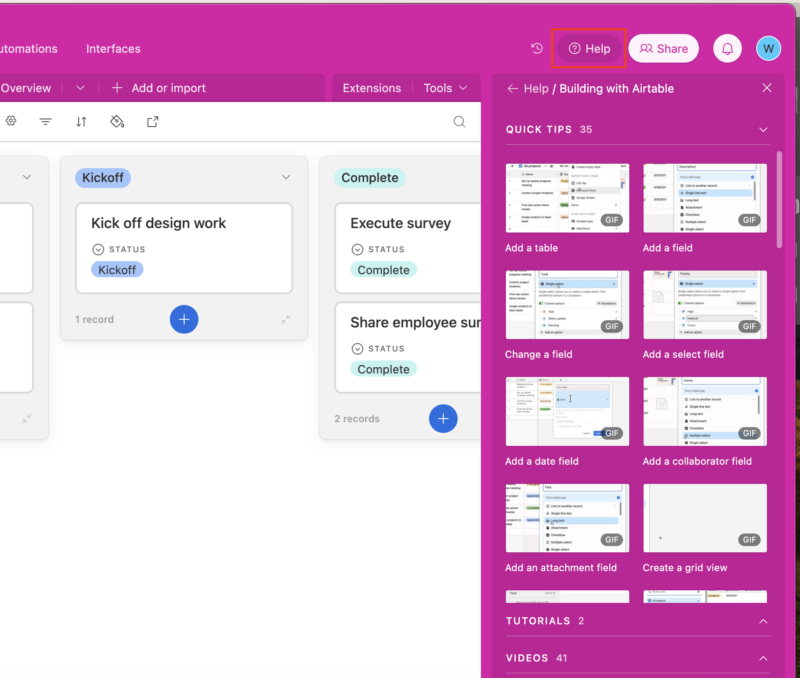
Email Support Speed & Quality
Unfortunately, Airtable doesn’t offer live chat or phone support. Email is the primary method to communicate with the customer support team, and they typically respond within one to two business days. We actually heard back from the support team within 24 hours, and we found the help to be useful and informative.
Other than that, there is a chatbot available on the Airtable website that can help you with basic questions or troubleshooting and connect you with the support team via email.
Users have given mixed opinions about Airtable’s customer service. Some are pleased with the support team’s helpfulness, while others have expressed displeasure with the lack of direct contact options.
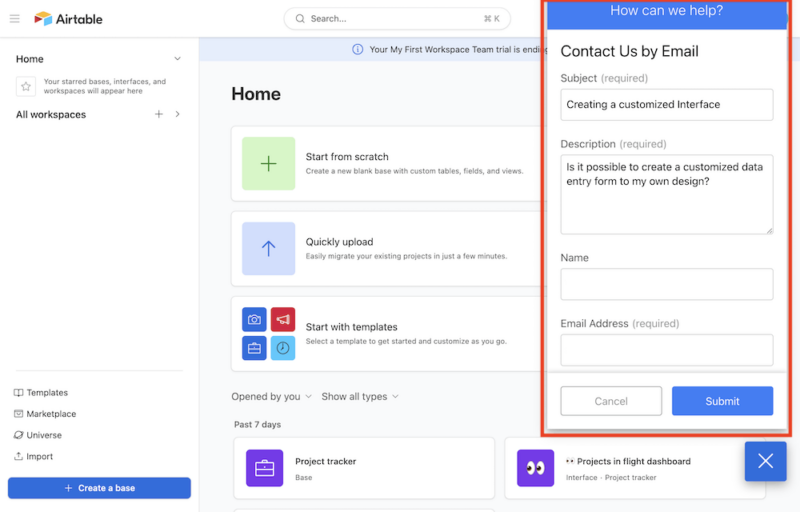
Airtable vs Other Project Management Services: How Does It Compare?
It’s clear that Airtable has a lot of great features and an appealing interface, but here we’ll take a closer look at what Airtable does better and worse than its competitors. Remember, though, that the platform you choose ultimately depends on your needs and preferences.
Airtable vs monday.com
monday.com is the best project management tool on the market. The similarities between Airtable and monday.com lie in their intuitive and colorful interfaces and core functions for task management. Airtable shines in its database management tools and has a better free plan, making it ideal for those who work extensively with data. monday.com outperforms in collaboration features.
Airtable vs ClickUp
Both Airtable and ClickUp are versatile task management tools with a wide range of features. While Airtable stands out with its database capabilities, ClickUp offers more comprehensive tools in task management, team communication and workflow automation. It also has more paid plans, but its interface isn’t as intuitive as Airtable’s.
Community Feedback: Airtable Reviews on Reddit & Social Media
As we read reviews on Reddit and social media, Airtable receives generally positive feedback from the community. Many users appreciate its versatility.
However, Airtable’s flexibility can be overwhelming for some users, especially non-tech-savvy people. One video on YouTube stated that one of the reasons you shouldn’t use Airtable as a CRM is that its flexibility can lead to disorganized data and confusion when teams grow larger.
The Verdict: Is Airtable Worth It?
If you’re dealing with databases and projects, whether an inventory database or product operations, Airtable serves as a go-to tool for you. Its intuitive interface and customizable options make it easy to tailor the app to meet your project’s needs. We highly recommend the Airtable free plan, but the updated pricing may make you reconsider upgrading to a paid plan.
However, Airtable’s flexibility can be both a blessing and a curse. While it makes customization easy, it can also lead to a steeper learning curve for beginners and disorganization when teams grow larger. Additionally, it might not be the best choice if your work requires a lot of complex formulas or advanced project management tools.
What has been your experience with Airtable? Have you found it helpful for your database and project management needs? Are there any specific features that you wish Airtable had? We would love to hear your thoughts. If you have any questions or would like to share your experience, please feel free to comment below. Thank you for reading our review!
FAQ: Airtable Review
Airtable is best used for database management and project management. Other solid use cases for Airtable include data analysis, app creation, content production and much more.
Airtable doesn’t have all the advanced features that other dedicated database software offers. Airtable’s collaboration tools especially are not as robust as other project management tools.
The choice between Airtable and Excel depends on the specific use case and personal preferences. Airtable offers a more visual and intuitive interface and more customization options, like linking records and custom views.






